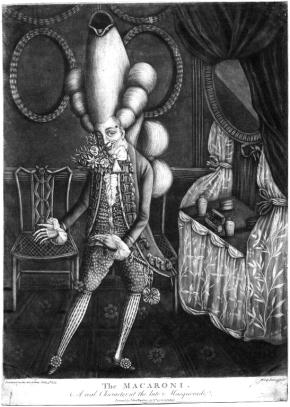

|
 All European cuisines have a pasta of some sort, and England is no exception. Home-made pasta shapes appear now-and-again over the centuries in such dishes as Loseyns from the 1300's, Macrow or Stokenchurch Pie. Pasta became more popular after the introduction, from Italy, of the machine-made dried product in the 18th Century. This style of pasta then came to be incorporated into a number of English dishes, such as Buckinghamshire Rabbit Pie and Macaroni Cheese  'The Macaroni' by Philip Dawe, 1773 In the 1770's the word macaroni came to mean a dandy or fop, a member of a set of young men who had travelled in Europe and imitated what they thought were Continental fashions, including strange Continental food. In the Oxford Magazine of 1770 we find, "There is indeed a kind of animal, neither male nor female, a thing of the neuter gender, lately started up amongst us. It is called a Macaroni. It talks without meaning, it smiles without pleasantry, it eats without appetite, it rides without exercise, it wenches without passion." See: Buckinghamshire Rabbit Pie Durham Cutlets Macaroni Cheese Macaroni Pudding Macrows or Maccherone Roman Pie Stokenchurch Pie  |
|
MORE FROM Foods of England... Cookbooks ● Diary ● Index ● Magic Menu ● Random ● Really English? ● Timeline ● Donate ● English Service ● Food Map of England ● Lost Foods ● Accompaniments ● Biscuits ● Breads ● Cakes and Scones ● Cheeses ● Classic Meals ● Curry Dishes ● Dairy ● Drinks ● Egg Dishes ● Fish ● Fruit ● Fruits & Vegetables ● Game & Offal ● Meat & Meat Dishes ● Pastries and Pies ● Pot Meals ● Poultry ● Preserves & Jams ● Puddings & Sweets ● Sauces and Spicery ● Sausages ● Scones ● Soups ● Sweets and Toffee ● About ... ● Bookshop ● Email: [email protected] COPYRIGHT and ALL RIGHTS RESERVED: © Glyn Hughes 2022 BUILT WITH WHIMBERRY |